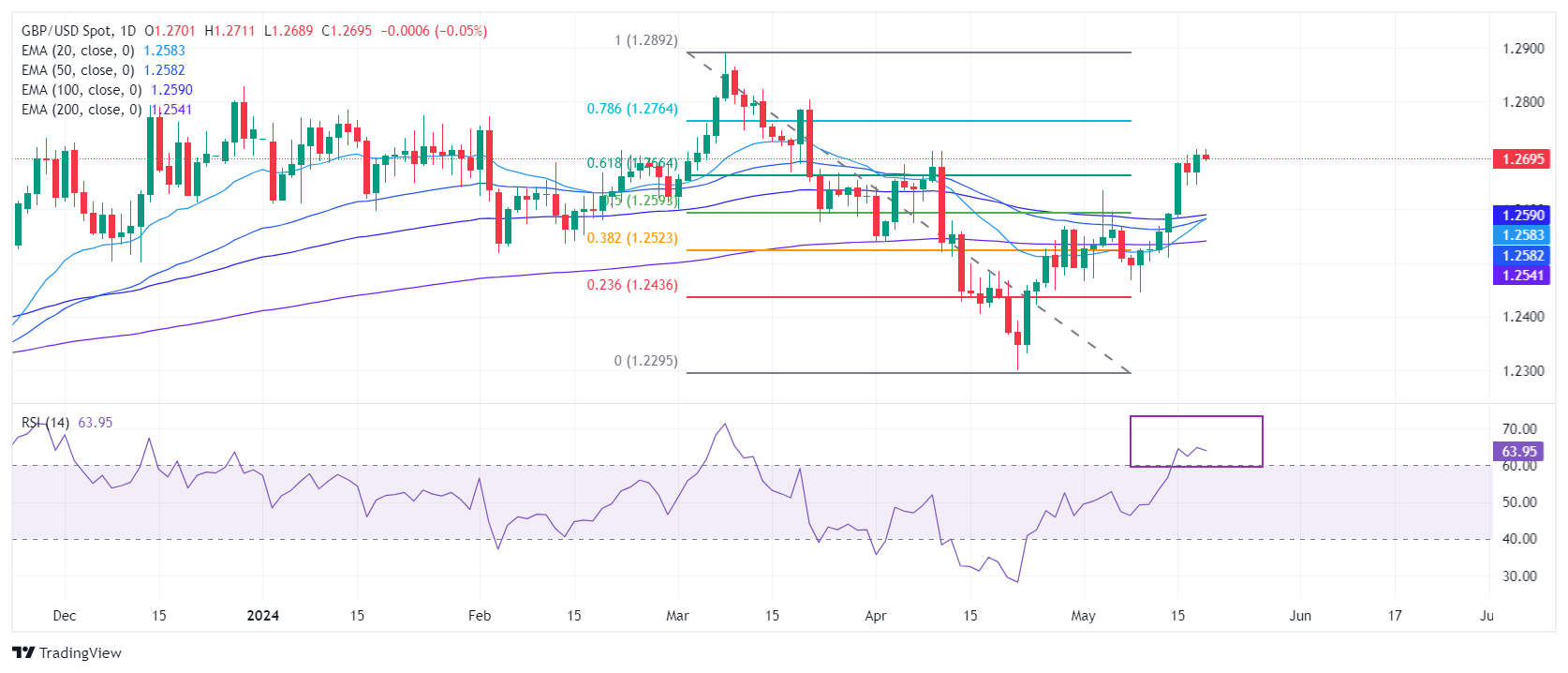Pound Sterling clings to gains on cheerful market mood, UK inflation in focus

- The Pound Sterling holds strength near 1.2700 as investors turn risk-averse on firm Fed rate-cut hopes.
- April’s UK headline inflation is expected to return to near 2%.
- This week, investors will focus on the UK inflation for April and the FOMC minutes.
The Pound Sterling (GBP) trades close to an almost two-month high around 1.2700 in Monday’s European session. The GBP/USD pair strengthens as the US Dollar (USD) is on the back foot as financial markets remain confident that the Federal Reserve (Fed) will start lowering interest rates from the September meeting.
Investor confidence in Fed rate cuts has strengthened due to a decline in the United States Consumer Price Index (CPI) data and easing labor market conditions as suggested by recent Employment and Initial Jobless Claims data.
In spite of unsupportive economic indicators, Fed policymakers remain leaning towards a restrictive interest rate stance as a one-time decline in inflation is insufficient to build confidence that price pressures will sustainably return to the desired rate of 2%.Going forward, investors will focus on the Federal Open Market Committee (FOMC) minutes, which will be published on Wednesday. The FOMC minutes are expected to show that policymakers emphasized keeping interest rates restrictive for a longer period.
Daily digest market movers: Pound Sterling strengthens while US Dollar is on the back foot
- The Pound Sterling exhibits strength near the round-level resistance of 1.2700 against the US Dollar. The GBP/USD pair remains upbeat as the appeal for risk-perceived assets has improved amid firm speculation that the Federal Reserve will start reducing interest rates from the September meeting. S&P 500 futures have posted decent gains in the European session.
- This week, the strength of the Pound Sterling will be tested on the grounds of the United Kingdom (UK) inflation data for April, which will be published on Wednesday. The UK Office for National Statistics (ONS) is expected to show that annual headline CPI declined to 2.1% in April from the prior reading of 3.2%. The core CPI, which excludes volatile items such as food and energy prices, is estimated to have softened to 3.7% in April from 4.2% a motnh earlier.
- The expected decline in inflationary pressures will boost expectations of rate cuts by the Bank of England (BoE). Investors expect that the BoE will start reducing interest rates from the June meeting. The scenario would be unfavorable for the Pound Sterling as policymakers will cut interest rates for the first time since March 2020. Historically, higher interest rates by the nation’s central bank reduce liquidity inflows into the economy, which strengthens the currency’s appeal.
- Before the inflation data is released, investors will focus on the commentaries from BoE Deputy Governor Ben Broadbent and BoE Governor Andrew Bailey on the interest rate outlook, which are scheduled for Monday and Tuesday, respectively.
Technical Analysis: Pound Sterling rises to 1.2700
The Pound Sterling advances to an almost two-month high near 1.2700. The GBP/USD pair is expected to remain in the bullish trajectory as all short-to-long-term Exponential Moving Averages (EMAs) are sloping higher, suggesting a strong uptrend. The Cable has retraced 61.8% of losses from March’s high of around 1.2900.
The 14-period Relative Strength Index (RSI) has shifted into the bullish range of 60.00-80.00, suggesting that the momentum has leaned toward the upside.
Pound Sterling FAQs
The Pound Sterling (GBP) is the oldest currency in the world (886 AD) and the official currency of the United Kingdom. It is the fourth most traded unit for foreign exchange (FX) in the world, accounting for 12% of all transactions, averaging $630 billion a day, according to 2022 data. Its key trading pairs are GBP/USD, aka ‘Cable’, which accounts for 11% of FX, GBP/JPY, or the ‘Dragon’ as it is known by traders (3%), and EUR/GBP (2%). The Pound Sterling is issued by the Bank of England (BoE).
The single most important factor influencing the value of the Pound Sterling is monetary policy decided by the Bank of England. The BoE bases its decisions on whether it has achieved its primary goal of “price stability” – a steady inflation rate of around 2%. Its primary tool for achieving this is the adjustment of interest rates. When inflation is too high, the BoE will try to rein it in by raising interest rates, making it more expensive for people and businesses to access credit. This is generally positive for GBP, as higher interest rates make the UK a more attractive place for global investors to park their money. When inflation falls too low it is a sign economic growth is slowing. In this scenario, the BoE will consider lowering interest rates to cheapen credit so businesses will borrow more to invest in growth-generating projects.
Data releases gauge the health of the economy and can impact the value of the Pound Sterling. Indicators such as GDP, Manufacturing and Services PMIs, and employment can all influence the direction of the GBP. A strong economy is good for Sterling. Not only does it attract more foreign investment but it may encourage the BoE to put up interest rates, which will directly strengthen GBP. Otherwise, if economic data is weak, the Pound Sterling is likely to fall.
Another significant data release for the Pound Sterling is the Trade Balance. This indicator measures the difference between what a country earns from its exports and what it spends on imports over a given period. If a country produces highly sought-after exports, its currency will benefit purely from the extra demand created from foreign buyers seeking to purchase these goods. Therefore, a positive net Trade Balance strengthens a currency and vice versa for a negative balance.
